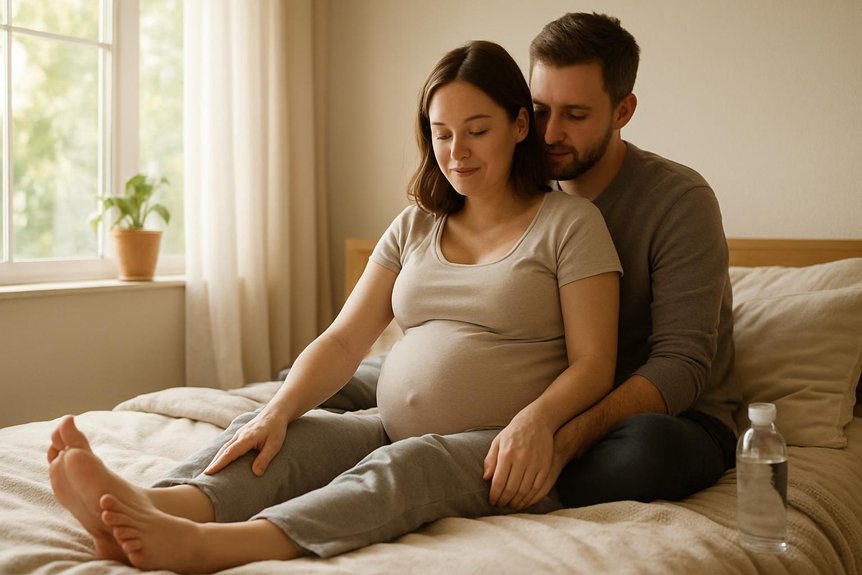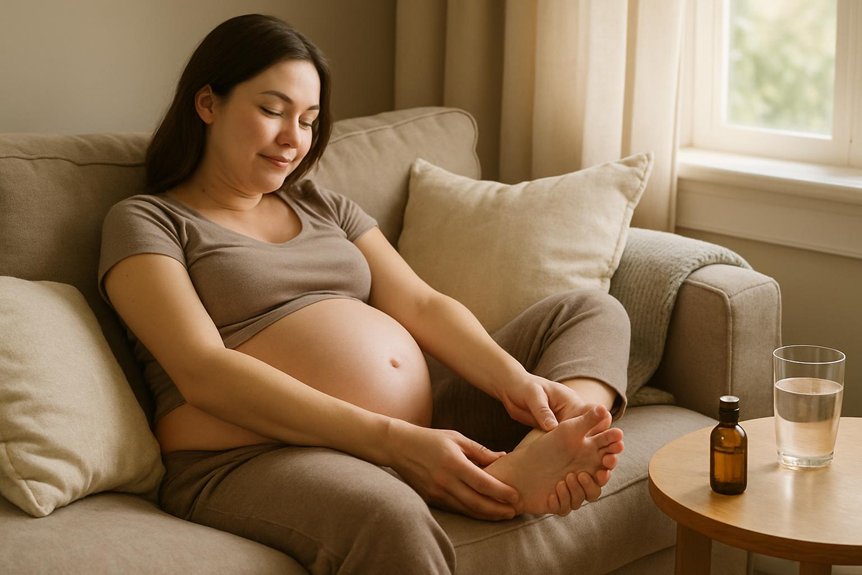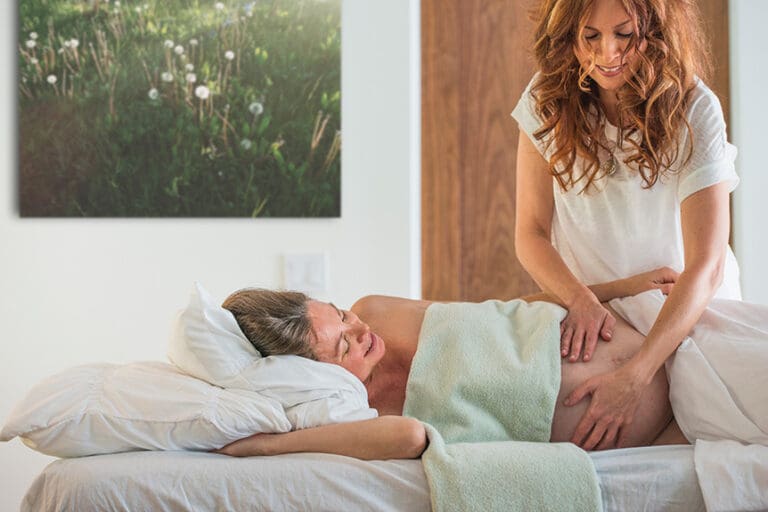Gentle foot and lower-leg massage is generally safe in pregnancy when done with light to moderate pressure and pregnancy-appropriate positioning. It can reduce edema, ease aching arches, improve venous and lymphatic return, and calm the nervous system. Avoid deep tissue work and pressure on contraindicated points. Stop and seek care if swelling is sudden or accompanied by pain, warmth, redness, breathlessness, headache, vision changes, or high blood pressure. Trained therapists use tailored, safe techniques that can enhance comfort and mobility further.
Is It Safe to Massage Swollen Feet While Pregnant?

When performed by a trained practitioner and with appropriate precautions, gentle foot and lower-leg massage is generally considered safe during uncomplicated pregnancy and can help ease swelling (oedema), discomfort, and fatigue.
Safety rests on light-to-moderate pressure, avoiding deep work over the calves, and steering clear of known contraindicated points when there are risk factors.
At Spa & Massage clinics in London, therapists follow pregnancy massage with specific protocols: client side-lying or semi-reclined positioning, unscented or pregnancy-safe oils, careful pressure monitoring, and shorter, rhythmic strokes directed toward the heart to support circulation.
A specialized technique such as deep tissue massage is not typically recommended for swollen feet during pregnancy, as it uses firmer pressure that may not be suitable for this condition.
Medical red flags—sudden one-sided swelling, calf pain, warmth, shortness of breath, severe headache, or visual changes—warrant urgent assessment, not massage.
For high-risk pregnancies, prior approval from a midwife or obstetrician is advised.
Appointments are scheduled to align with energy levels and comfort.
Benefits of Gentle Foot and Ankle Massage in Pregnancy
A gentle foot and ankle massage can help reduce pregnancy-related oedema, ease aching arches, and support venous and lymphatic return, improving comfort and mobility. Evidence suggests light, rhythmic strokes around the feet and ankles can decrease fluid pooling, lessen nighttime cramping, and calm the nervous system.
Many notice improved range of motion in toes and ankles, steadier balance, and better sleep after sessions.
From Spa & Massage’s perspective, consistent, gentle work also supports circulation without provoking tenderness, which is vital in the third trimester. Clients often report less tightness in the calves and fewer end‑of‑day throbs.
Therapists prioritise positioning that protects the lower back and uses unscented or pregnancy‑safe oils to minimise skin reactivity.
Safe Techniques You Can Use at Home
Though professional guidance is ideal, several gentle, low‑risk techniques can be performed at home to ease pregnancy‑related foot swelling. From Spa & Massage’s clinical perspective, the aim is to support lymphatic return without provoking pressure-sensitive tissues.
- Position: Lie on the left side or sit with feet elevated above the hips; hydrate beforehand.
- Stroke: With a light, lotion‑aided glide, sweep from toes toward ankles, then calves, always moving proximally. Pressure should be feather‑light to moderate—never painful.
- Pumping: Using the pads of the thumbs, apply slow, rhythmic presses around the ankles and along the Achilles, releasing after each count of three.
- Toe mobilisations: Gently circle each toe and ankle to stimulate circulation.
- Finish: Apply cool (not ice‑cold) compresses 5–10 minutes. Our therapists recommend resting and gentle ankle pumps afterward.
When to Avoid Massage and Seek Medical Advice
Having tried gentle home techniques, some situations warrant pausing massage and contacting a midwife, GP, or maternity triage.
Immediate advice is recommended if one leg is markedly more swollen than the other, there is calf pain, warmth, redness, or sudden breathlessness—signs that can suggest a clot. Massage should also be avoided with new severe headache, visual changes, chest or upper‑abdominal pain, rapid swelling of hands/face, or high blood pressure concerns—possible indicators of pre‑eclampsia.
They should seek assessment for sudden swelling after a long journey, recent falls, reduced baby movements, fever, broken skin, or suspected infection. Persistent numbness, tingling, or unusual coldness in the feet also warrants review.
At Spa & Massage, therapists advise prioritising medical evaluation first; safe touch can resume once clinicians confirm it’s appropriate.
How Our Therapists Support You at Spa & Massage
Why choose Spa & Massage during pregnancy? Their therapists provide clinically informed, gentle care tailored to each trimester. Appointments begin with a concise screening for swelling patterns, pain, blood pressure concerns, and red flags (e.g., sudden asymmetry, calf pain), with referrals when indicated.
Positioning is carefully adjusted—side-lying with cushions to reduce vena cava pressure—and strokes are slow, proximal-to-distal, avoiding deep pressure over the inner ankles and contraindicated points.
They use light, hypoallergenic oils and apply lymphatic-inspired techniques to reduce ankle and foot edema while protecting joint laxity.
Therapists explain home strategies: short walks, ankle pumps, elevation above heart level, hydration, and compression guidance if approved by a clinician.
Aftercare includes pacing activity, gentle calf stretches, and monitoring for sudden changes requiring medical review.
Conclusion
Like a well-tended garden path after rain, swollen feet in pregnancy can be eased with careful steps. Gentle, evidence-based techniques—light effleurage, ankle mobilisations, elevation, hydration—help redirect the “puddles” of fluid without disturbing the soil. Avoid pressure on contraindicated points and seek medical guidance for sudden, uneven, or painful swelling. With informed practice at home and skilled support from trained therapists, comfort returns safely and steadily—reassuring proof that mindful care can smooth the way until new life blossoms.



